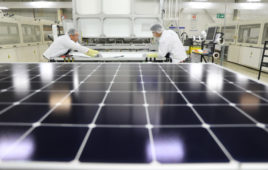Update 8/7/2022: The Inflation Reduction Act passed the Senate and now moves to the House and is expected to pass by the end of the week, according to The New York Times.
On July 27, Senators Joe Manchin and Chuck Schumer announced a reconciliation deal they’re now calling the “Inflation Reduction Act of 2022” that includes about $370 billion in energy and climate spending, according to Politico.
The Inflation Reduction Act includes a 10-year extension of the solar ITC at 30% and includes direct pay for nonprofit and governmental entities. According to ROTH Capital Partners, the ITC could reach 50% for larger projects depending on domestic product use and project location. The U.S. Energy Information Administration released a report today that found extending the ITC through 2050 would increase solar generation by 10%.
The reconciliation bill also introduces a 30% ITC for standalone storage, which the industry has been pushing for to reduce the cost of this crucial technology. Manufacturing credits for solar cells (4¢/W) and modules (7¢/W) made the cut too.
Some in the industry were disheartened that the bill doesn’t include residential solar refundability — meaning homeowners without tax liability could still get a check for the refund amount, with the aim of making solar more affordable for lower-income individuals.
“We are disappointed that refundability for 25D was not included in the current version of the Inflation Reduction Act,” said Karla Loeb, a founding member of Residential Renewables for All, an ad hoc coalition that has worked to push refundability. “However, there may be other opportunities to establish policies that promote equitable solar access for Main Street Americans, which will be accelerated by the generational clean energy wins captured in this legislation.”
Overall, though, the solar industry reacted jubilantly to the news.
“If the Inflation Reduction Act of 2022 passes with the 10-year extension of the investment tax credit (ITC) and a separate credit for standalone energy storage, it will benefit our community solar projects in several ways,” said Aaron Halimi, founder and president of Renewable Properties, a San Francisco-based owner and developer of community solar projects in 14 states. “First, it will give us solar project finance certainty, enabling Renewable Properties to plan and develop community solar projects without worrying about next year’s deadline. Second, a more predictable future for financing will also allow us to develop more projects in more community solar states. Third, with the energy storage ITC, we’re now able to accelerate the development of energy storage, helping to stabilize the grid for utilities and for local residents where we may have not been able to develop before. This legislation, if it passes, is truly a triple win for the environment, for utilities, and for the communities where we will build our projects.”
Advocates are encouraging Congress to quickly pass the bill.
“Inflation and energy are top of mind for Americans, and we have maintained that lawmakers must stay at the negotiating table and cut a deal on federal clean energy investments to help bring down the cost of electricity for homes and businesses,” said SEIA president and CEO Abigail Ross Hopper in a statement. “With long-term incentives for clean energy deployment and manufacturing, the solar and storage industry is ready to create hundreds of thousands of new jobs and get to work building out the next era of American energy leadership. This is a crucial window of opportunity that we cannot miss, and now Congress must seal the deal and pass this legislation.”
The bill is expected to reach the Senate floor next week.
Updated on July 29.





How does the govt spending MORE money reduce inflation? Isn’t the Feds raising rates to SLOW spending and now they want to spend MORE money and mis-name it and call it ‘inflation reduction’- doesn’t make sense….
I’ve this noted as being effective in 2022, but if it’s 30% for 10 years stepping down in 2033 to 26%, then 10 years would be 2023 through 2032. If it’s retroactive for all 2022 installations, 10 years would end in 2031 and step down to 26% in 2032. Does the bill have specific language re the exact dates?
It’s 725 pages and includes “interconnections” , just doesn’t say “massive”……Doesn’t say massive solar deployment either but you get the idea…
This is HUGE and GREAT NEWS!!! Solar tax credits and incentives are vital for solar panel adoption. We need to continue pushing to promote and develop solar installs for residential and commercial, and especially power-hungry industries. And alongside these solar incentives should be electric vehicle incentives. EVs are a huge stop towards reducing climate change and preventing global warming. We hope this passes and continues to push the solar movement forward!
Still one is looking at something that may pass but what will the “final” package contain? It has been a lazy Congress practice to “birth” 2,000-3,000 page bills with gaps to insert “riders” or “spot bills”. All of this can Gerrymander monies spent to programs not particularly useful for a particular goal, (decarbonization of the grid by 2035). Massive grid infrastructure needs to be addressed and (AGGRESIVELY) addressed now and not later. One has the land available, look at the vast desert around the Nevada proving grounds to construct 1GWp or larger solar PV farms and plenty of acreage available for giga-sized energy storage facilities to grab all the sun during the day and time shift this to nightime. The missing secret ingrediant is massive transmission connection and interconnection of the grid from coast to coast and north to south. The wholesale grid needs a lot of love and a whole lot of simplification using Federal rights of ways to move power around the country.
And to think a group of 30–50-year-old men created a country’s constitution on a single sheet of paper.
Those clowns in office now would need 10,000 pages.
For the preamble